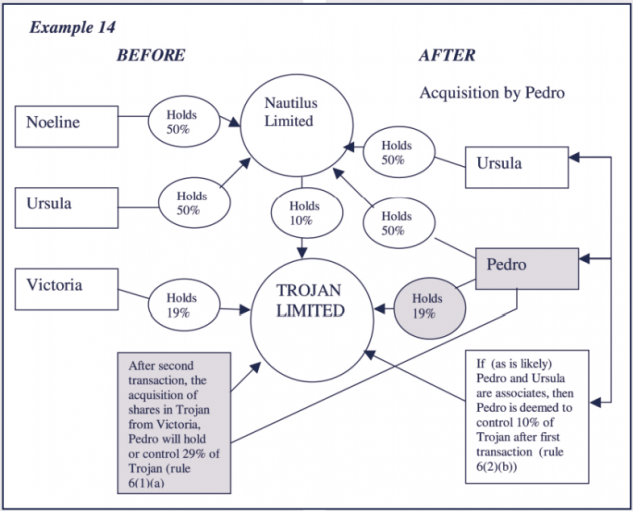Part 2: The Deeming Provisions in Rule 6(2)
Published 1 September 2002
Another important anti-avoidance measure is found in the three deeming provisions in rule 6(2). These provisions address constraints that may otherwise limit the operation of fundamental rule 6(1), particularly in relation to transactions that occur upstream from the Code company. The Code was drafted on the premise that parties should not be able to use upstream transactions to accomplish objectives that could not be attained by transactions in shares of the Code company itself.
Rule 6(2)(a)—Concert acquisitions
Concert acquisitions can be implemented at either the Code company level or upstream.
Example 8
Victoria owns 60% of the shares in Code company Trojan Limited. Acting in concert only for purposes of the acquisition, four persons each purchase one fourth of Victoria’s holding in Trojan Limited.
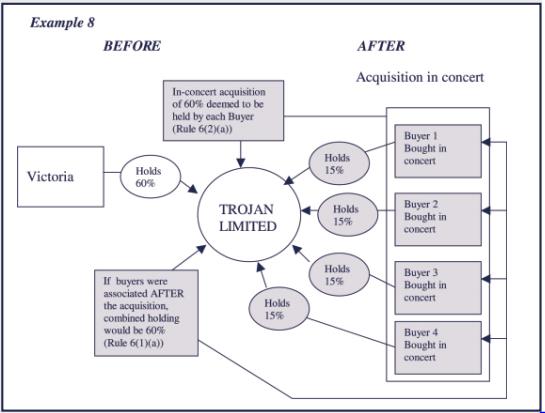
While the transaction enables Victoria to transfer control without needing the agreement of the other shareholders, it does not, without more, fall within fundamental rule 6(1) because rule 6(1) as expressed is concerned with the control position after the acquisition.
Taken individually, none of the purchasers acquires more than 20%. If the purchasers qualified as associates after the event their holdings would be aggregated, thus causing each of them to breach rule 6(1)(a). However, as the concert action was limited only to the acquisition, it is not clear that the purchasers are associates after the event.
Rule 6(2)(a) ensures that the concert acquisition is caught by the fundamental rule. Under rule 6(2)(a), each of the four purchasers is deemed to become the holder and controller of the 60% stake in Trojan Limited. As a result, each of them contravenes rule 6(1)(a).
Concert acquisitions upstream
Rule 6(2)(a) also applies to concert acquisitions that occur upstream of the Code company.
Example 9
Victoria holds all the shares in Nautilus Limited that in turn owns 60% of the shares in Code company Trojan Limited. Purporting to act in concert only for purposes of the acquisition, four persons each purchase one fourth of Victoria’s holding in Nautilus Limited.
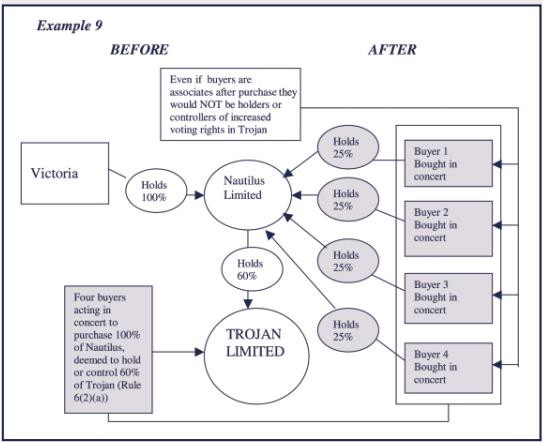
In this situation, the attempt to limit the scope of the concert action is unlikely to be effective as four equal shareholders in a closely-held company are very likely to be, depending on the facts, associates. However, even if the purchasers do qualify as associates, there are other difficulties in applying rule 6(1)(a) directly.
In this upstream example, where each purchaser acquires a minority shareholding in Nautilus Limited, none of them becomes the holder or controller of an increased percentage of voting rights in Trojan Limited, which is the threshold requirement of rule 6(1)(a). Here again, rule 6(2)(a) would apply to bring the upstream transaction under fundamental rule 6(1). The four purchasers are acting in concert together and end up controlling the 60% holding in Trojan Limited. Under rule 6(2)(a), each of them will be deemed to be the holder or controller of that 60% holding. This puts all four purchasers in breach of rule 6(1)(a).
Rule 6(2)(b)—Joint ventures
The fundamental rule also anticipates the use of joint ventures to hold and control shares at both the Code company level and upstream of the Code company.
Example 10 (Code company level example)
Victoria and Ursula each own 30% of the shares in Trojan Limited. They manage their combined holding as a joint venture. Pedro proposes to purchase Victoria’s holding and take over Victoria’s position in the joint venture.
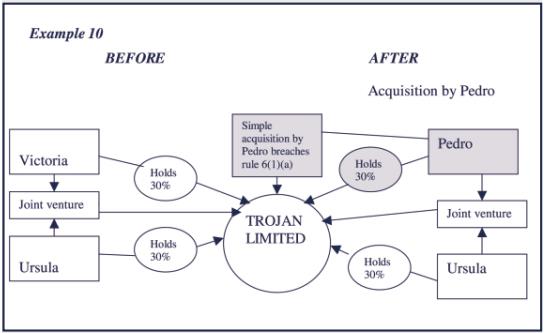
The transaction clearly triggers rule 6(1)(a) as it increases Pedro’s holding in Trojan Limited from 0% to 30%. The upstream equivalent is more problematic.
Example 11 (upstream example)
Victoria and Ursula hold respectively 60% and 40% of the shares in joint venture Nautilus Limited that in turn owns 30% of the shares in Code company Trojan Limited. Pedro proposes to purchase Victoria’s holding in Nautilus Limited.
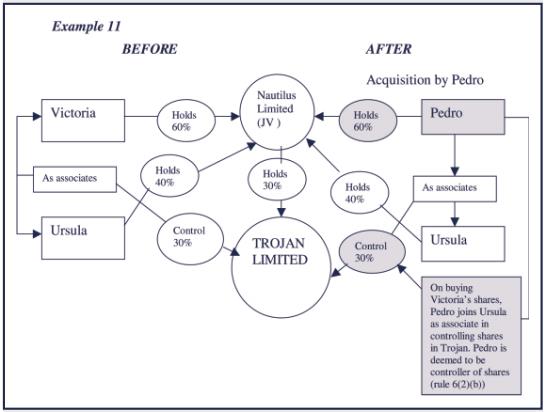
The transaction arguably will not breach rule 6(1). The transaction does not make Pedro the holder of any voting rights in Trojan Limited. The acquisition will provide Pedro with control over the 30% parcel in Trojan Limited via Pedro’s control over the affairs of Nautilus Limited. Pedro may argue that, even though he is a controlling shareholder in Nautilus Limited, the joint venture agreement prevents him from exercising effective control over Nautilus Limited and hence over the 30% parcel in Trojan Limited.
Rule 6(2)(b) addresses this argument. Prior to the transaction, Victoria and Ursula together (as members of Nautilus Limited) controlled 30% of the voting rights in Trojan Limited. The proposed transaction results in another person (Pedro) joining one of them (Ursula) in the controlling of those voting rights. Further, Pedro and Ursula will be controlling the shares as associates. (Even in the absence of an express joint venture agreement, a 60% member and 40% member in a two-person company will normally stand in a business relationship that will make them associates under rule 4(1)(d).)
Under rule 6(2)(b), this associate relationship suffices to deem Pedro to have become the controller of the 30% holding in Trojan Limited. As a result of the transaction, Pedro moves from control over 0% to deemed control over 30% of the voting rights in Code company Trojan Limited and thus breaches rule 6(1)(a).
Extent of scope of rule 6(2)(b)
In example 11, the same result may follow if Pedro acquires only a 10% holding in Nautilus Limited, i.e. by purchase from Victoria or by an issue of new shares by Nautilus Limited. In this situation, Pedro will be joining Victoria and Ursula in the controlling of Nautilus Limited’s 30% holding in Code company Trojan Limited. However, this alone is not sufficient to trigger the deeming rule in rule 6(2)(b). Also required is that Pedro joins Victoria and Ursula as associates in the controlling of the Trojan Limited shares.
It could be expected that Pedro would qualify as an associate of Victoria and Ursula if he joins their joint venture. However, even in the absence of an express joint venture agreement, it is likely that the three members of a closely-held company would stand in a business relationship that, in the absence of special circumstances, would qualify them as associates under rule 4(1)(d).
Rule 6(2)(c) - Inter-Associate Transfers
As discussed in connection with example 4, when a person has associates, under rule 6(1)(a) the associates’ holdings will constrain the person’s acquisitions from third parties. As applied to transfers between associates, fundamental rule 6(1) operates in a straight-forward manner so long as the transaction involves shares in the Code company itself.
Example 12
Seven associates each own 7% of the shares in Code company Trojan Limited. One associate (Pedro) proposes to acquire the holding of another associate (Victoria).
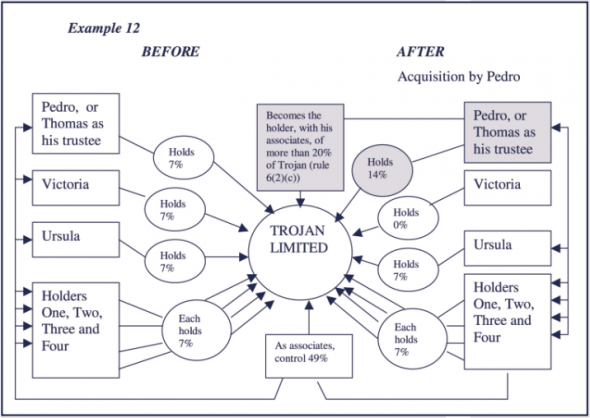
By reason of the transaction, Pedro will increase his holding of voting rights of Trojan Limited from 7% to 14%. As, after the event, Pedro and the other five associates hold in total more than 20%, the transaction will breach rule 6(1)(a). (Note that, due to the associate relationship (e.g. joint voting agreement), the purchase may not result in Pedro obtaining effective control over an increased percentage of voting rights.)
The rule cannot be circumvented by Pedro’s use of a nominee or other trustee (Thomas) to hold his, and to acquire Victoria’s, shares. In that situation, the transaction will increase Thomas’s holding from 7% to 14%. After the transaction, Thomas will qualify as an associate of the other five members under rule 4(1)(e), i.e. by reason of the associate relationship between Thomas and Pedro and the latter’s associate relationship with the other five members. As after the transaction, Thomas and the other five members hold as associates more than 20% in Trojan Limited, the transaction will cause Thomas to breach rule 6(1)(a).
Inter-associate transactions upstream
Inter-associate transactions are more complex when they occur upstream from the Code company.
Example 13
The 700 shares in Nautilus Limited are held in equal parcels by seven associates. Nautilus Limited owns 30% of the shares in Code company Trojan Limited. Associate Pedro proposes to acquire associate Victoria’s holding in Nautilus Limited.
After the transaction, Pedro and the five remaining associates will control (via Nautilus Limited) more than 20% in Trojan Limited. However, this does not suffice to breach rule 6(1)(a). The issue is whether the transaction will satisfy the trigger requirement in rule 6(1), i.e. result in Pedro becoming the holder or controller of an increased percentage of voting rights in Trojan Limited. Whilst the transaction will increase Pedro’s holding in Nautilus Limited from 100 shares (around 14%) to 200 shares (around 28%), it is unlikely that, for purposes of rule 6(1)(a), this would result in Pedro becoming the controller of an increased percentage of voting rights in Trojan Limited. Both before and after the transaction, Pedro remains a minority shareholder and, as such, is unable to control the affairs of Nautilus Limited.
The deeming rule in rule 6(2)(c) aims to achieve the same result in this upstream situation as occurs in the very comparable inter-associate transaction at the Code company level explained in example 12.
Prior to the transaction, 30% of the voting rights in Trojan Limited are controlled by a person (Pedro) together with his six associates, via their ownership of Nautilus Limited. By reason of the proposed transaction, Pedro will increase (from 14% to 28%) the extent to which he shares in the controlling of those shares. Under rule 6(2)(c), this is deemed to result in an increase in the percentage of voting rights in Trojan Limited held or controlled by Pedro. This deemed increase satisfies the trigger requirement in rule 6(1)(a) and places Pedro in breach of the fundamental rule.
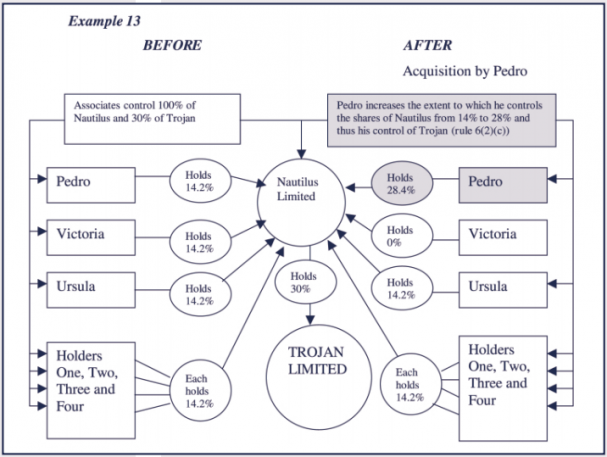
Acquisitions at both the Code company level and upstream
Acquisition strategies can involve transactions at both the Code company level and upstream.
Example 14
Noeline and Ursula each hold one half the shares in Nautilus Limited that in turn owns 10% of the shares in Code company Trojan Limited. Pedro first purchases Noeline’s stake in Nautilus Limited and then Pedro purchases from third party Victoria a 19% holding in Trojan Limited.
Following example 11, Pedro will be deemed, under rule 6(2)(b), to be the controller of the 10% holding in Trojan Limited if, as is likely, Pedro and Ursula are associates after the transaction.
In the subsequent acquisition from Victoria, Pedro will increase his control in Trojan Limited from 10% to 29% and thus breach rule 6(1)(a). It is arguable that the same result follows without regard to rule 6(2)(b). The two shareholders in a 50/50 company such as Nautilus Limited, would almost certainly qualify as associates of Nautilus Limited under rule 4(1)(d) by reason of a business relationship. In the subsequent Pedro/Victoria transaction, Pedro increases his holding in Trojan Limited from 0% to 19%. Because, after this transaction, associate Nautilus Limited’s 10% holding is aggregated with Pedro’s 19% holding, the transaction places Pedro in breach of rule 6(1)(a). The same result would follow if the order of the acquisitions were reversed.
